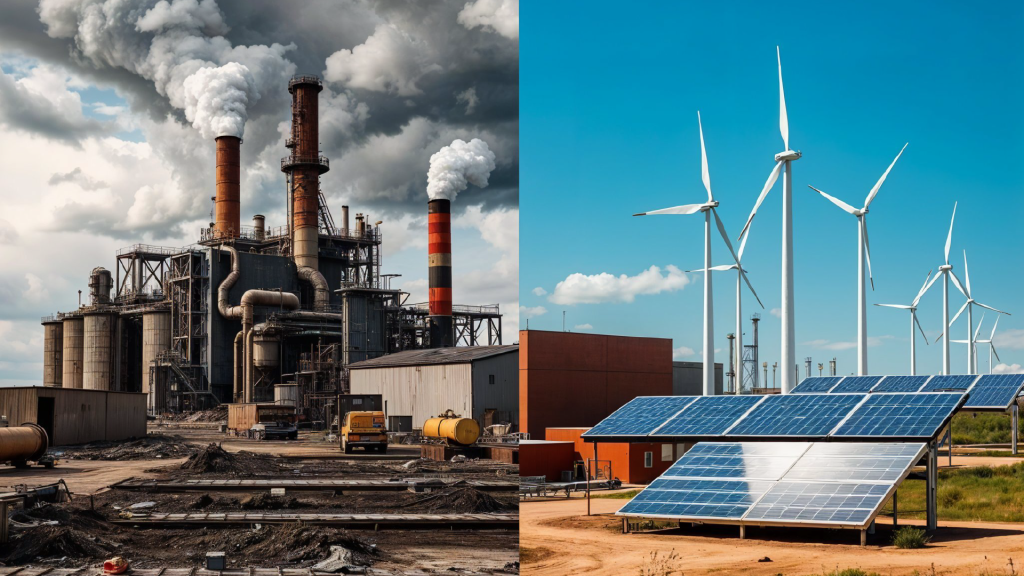It’s the final lap of a Formula 1 race.
Two drivers push their machines to the limit, one in a finely tuned, ultra-efficient hybrid, the other in an outdated gas-guzzler. The hybrid surges ahead, fueled by precision, optimization, and cutting-edge tech, while the old-school racer burns through fuel, struggling to keep up.
The finish line? A future where only the most efficient manufacturers survive.
Now, swap the racetrack for the global manufacturing sector, and the competitors are industries, companies, and even entire nations.
Some are in pole position, re-engineering their supply chains, slashing emissions, and securing their dominance in the new era of low-carbon production.
Others? They’re still in the pit lane, tweaking outdated models, hoping regulations won’t force them out of the race too soon.
This isn’t about sustainability for the sake of optics. It’s about who will win the future of manufacturing.
This Is More Than an Environmental Initiative
Forget the slow, bureaucratic net-zero commitments of the past decade. Manufacturing is now in an all-out sprint to decarbonize.
1. Governments are throwing billions into industrial sustainability initiatives—but only the fastest, smartest players will secure funding.
2. Investors are shifting capital toward companies that prove they can stay ahead of carbon regulations.
3. Trade policies are creating new barriers for high-emission goods, putting fossil-heavy manufacturers at risk of losing access to major markets.
And while some companies are setting the pace, others are already falling dangerously behind.
Net-Zero Manufacturing Is More Than Just Emissions Reduction
For decades, manufacturers have focused on efficiency as a cost-cutting strategy. Now, efficiency is a survival strategy.
1. More than price, companies are competing on carbon intensity.
2. The real front-runners are tracking emissions and reengineering their entire production models to slash carbon from the supply chain.
3. The laggards, meanwhile, are still treating net-zero like a future problem. One they’ll solve when regulations force them to.
This is a make-or-break moment for manufacturers worldwide.
What This Blog Delivers
This is not your run-of-the-mill net-zero think piece. This is a deep dive into the real winners and losers of the manufacturing sustainability race.
Who’s accelerating: The companies, industries, and regions leading the charge—and how they’re doing it.
Who’s falling behind: The manufacturers struggling to keep pace—and why their business models are at risk.
How to stay ahead: The key strategies manufacturers must adopt to remain competitive in a low-carbon world.
Because in this race, there’s no second place. The winners will dominate global trade and the losers may not survive.
Let’s take a closer look.
What’s Driving the Net-Zero Race in Manufacturing?
Suppose, there are two manufacturers—one in Europe, one in the U.S.—and they are bidding for a massive contract with a global electronics giant.
They both meet the quality specs, they both offer competitive pricing. But one of them has already slashed its carbon emissions, while the other is still figuring out a sustainability plan.
Guess who wins the deal?
The manufacturing world is being pushed, shoved, and pulled into net-zero. And the forces driving this transition are coming from every direction: governments, supply chains, investors, and consumers.
Some companies are already accelerating, locking in long-term advantages. Others? They’re scrambling to catch up.
Here’s why the race is moving faster than ever, and why waiting is no longer an option.
The Global Policy Divide: Why Some Countries Are Moving Faster Than Others
Not all manufacturing hubs are moving at the same speed when it comes to decarbonization. Some regions are setting the rules, while others are playing catch-up or resisting change altogether.
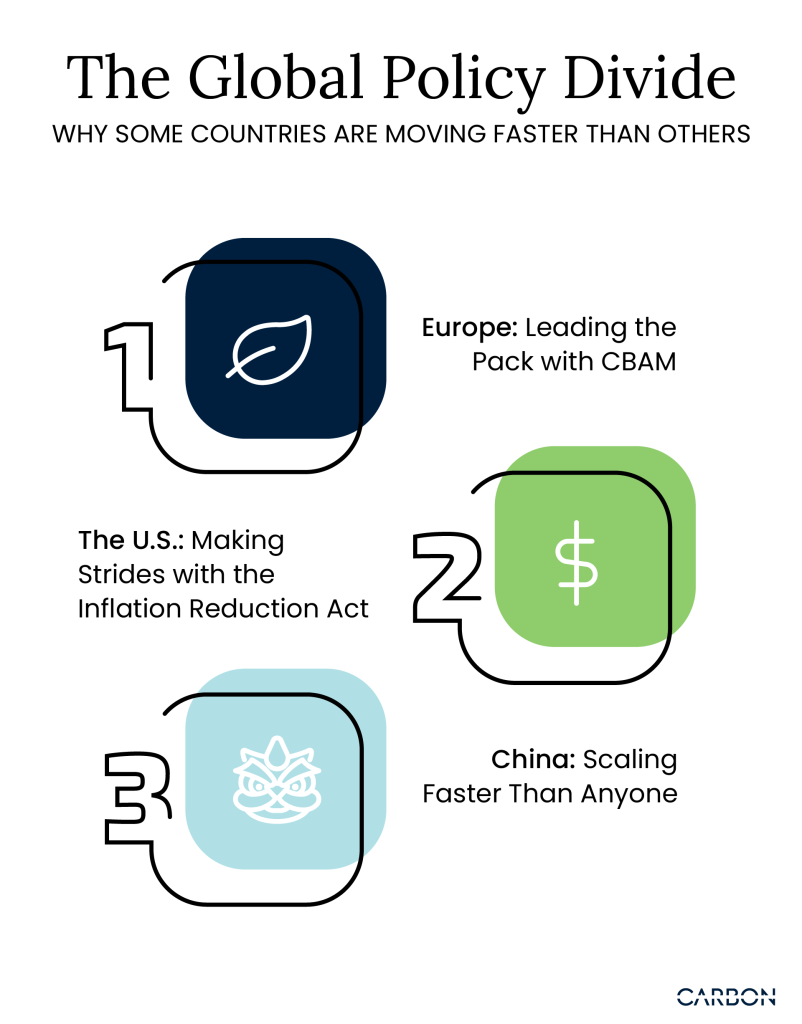
Europe: Leading the Pack with CBAM
If you’re a manufacturer trying to export to the EU, you better have your carbon numbers in order. The Carbon Border Adjustment Mechanism (CBAM) is one of the strictest climate policies, essentially a carbon tariff on imported goods with high emissions. If your factory runs on fossil fuels, Europe is about to make your exports a whole lot more expensive.
The U.S: Making Strides with the Inflation Reduction Act
While Europe is punishing carbon-heavy imports, the U.S. is throwing money at clean energy. The Inflation Reduction Act (IRA) is a $370 billion push to supercharge industrial decarbonization, Great news for American manufacturers who act fast. Bad news for those waiting for a regulatory nudge.
China: Scaling Faster Than Anyone
China is setting itself up to dominate. The country is pumping investment into EV batteries, solar, and industrial decarbonization tech at a rate no one can match. While other countries debate policies, China is already producing the clean technologies the rest of the world will have to buy.
What this means: If you’re a manufacturer in a slow-moving region, you might feel safe for now. But as trade barriers rise and customers demand low-carbon suppliers, companies in aggressive decarbonization regions will have a competitive edge.
Why Carbon Compliance Alone Won’t Be Enough
Think governments are the biggest drivers of net-zero? Think again. The real pressure is coming from the supply chain itself.
Your Biggest Customers Are Making the Rules
Major companies—Tesla, Unilever, Apple, BMW—are forcing their suppliers to track and cut emissions. They don’t care if your factory meets the minimum legal requirements. If you can’t meet their Scope 3 emissions standards, you won’t be on their supplier list.
Net-Zero Trade Barriers Are Coming
Governments are also building entire trade barriers around sustainability. If your products aren’t certified as low-carbon, you might soon struggle to export them.
What this means: If you’re only focused on carbon compliance, you’re already behind. The leaders are making themselves the obvious choice for global customers.
The Regional Competitiveness Factor: Which Industries Will Lose Market Share?
Some industries can afford to drag their feet on net-zero. Others? They’ll lose contracts, customers, and market share if they don’t adapt fast enough.
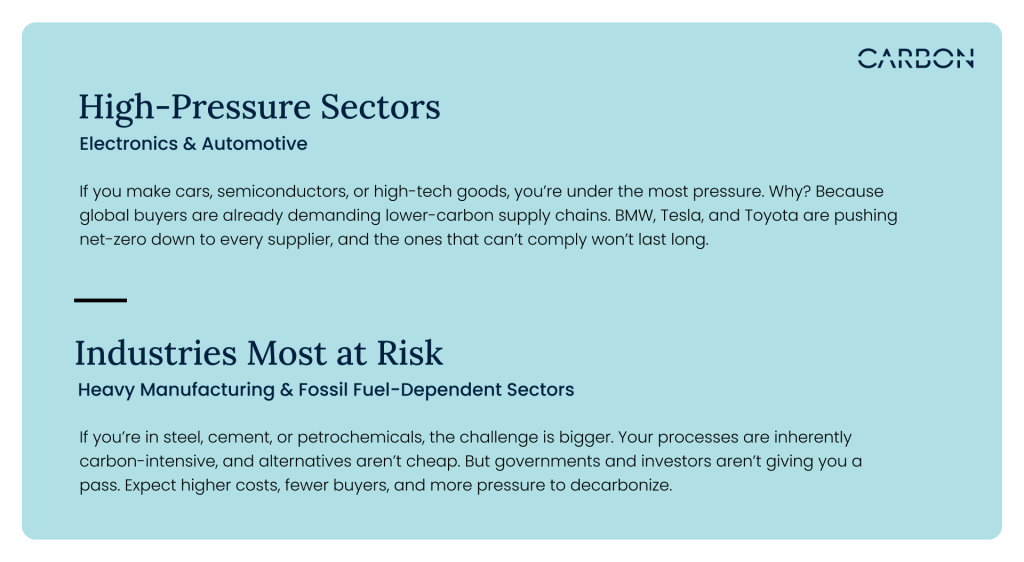
The Net-Zero Race Isn’t Slowing Down
1. Governments are raising the stakes with carbon tariffs and incentives.
2. Major customers are forcing sustainability into every supply chain.
3. Industries that fail to decarbonize will lose contracts, funding, and market share.
The manufacturing world is changing fast, and the companies that embrace this shift now will have a massive head start.
Next up: Which companies and industries are winning the net-zero race and how they’re doing it.
Who’s Leading? The Global Front-Runners in Sustainable Manufacturing
Some manufacturers are playing defense, scrambling to meet net-zero mandates.
But the real winners? They’re on offense, turning sustainability into a competitive edge.
Across the world, a handful of countries and industries are setting the standard. They’ve figured out how to cut emissions, lower costs, and win market share all at the same time.
So, who’s leading the charge? Let’s break it down.
Countries That Are Winning the Race
Some nations are going all in on green manufacturing, not just because it’s good for the planet, but because it’s good business.
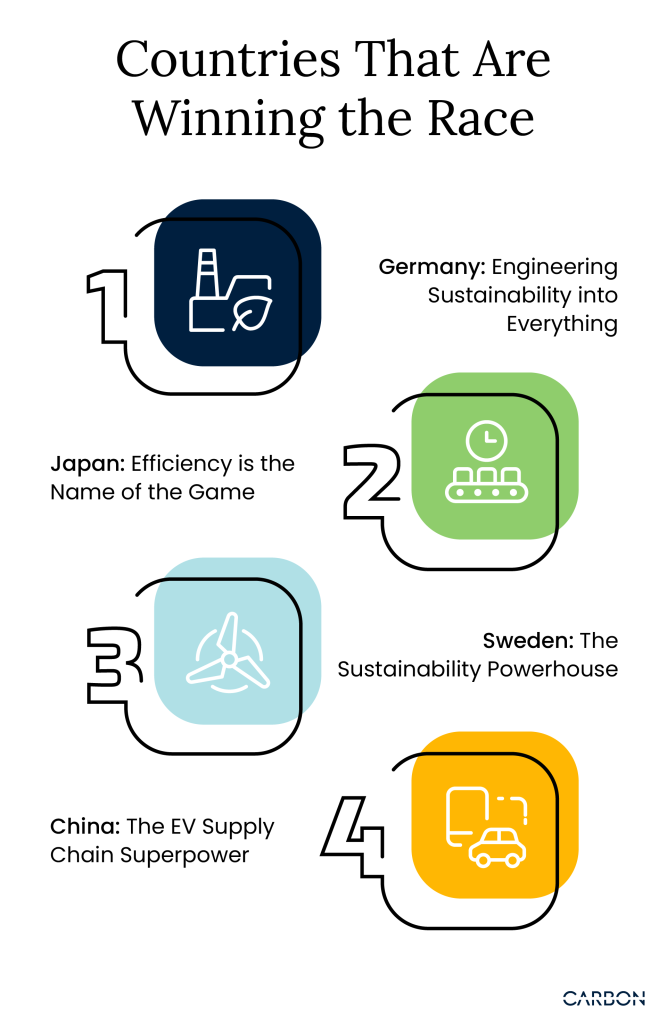
Germany: Engineering Sustainability into Everything
It has been ahead of the curve for years and Germany’s Energiewende (“energy transition”) policy has poured billions into renewable energy and industrial efficiency.
Now, it’s home to some of the most sustainable manufacturing hubs in the world, with industries adopting AI-driven energy management and hydrogen-based production.
The result is that German manufacturers are leading the EU’s push for carbon-neutral supply chains—and securing massive long-term contracts.
Japan: Efficiency is the Name of the Game
Japan is optimizing everything. From automotive to electronics, Japanese manufacturers have mastered energy efficiency, waste reduction, and closed-loop production systems.
Companies like Toyota and Panasonic are pioneering net-zero factories that minimize resource use while keeping output high. Japan has also bet big on hydrogen, positioning itself as a global supplier of clean energy tech.
Sweden: The Sustainability Powerhouse
Sweden has taken a bold approach, pushing green industrial policies that reward manufacturers for cutting emissions and penalize those that don’t. The country’s steel and mining sectors are transitioning to fossil-free production using green hydrogen, and companies like Volvo are rolling out fully carbon-neutral production lines.
China: The EV Supply Chain Superpower
While some countries are regulating their way to net-zero, China is outproducing everyone else in clean tech. It has poured investment into electric vehicle (EV) batteries, solar panels, and industrial decarbonization at an unprecedented scale.
Companies like CATL dominate the global EV battery market, while China’s solar manufacturing capacity dwarfs that of any other country. The message is clear: China plans to be the world’s green tech supplier and it’s already winning.
What this means: Manufacturers in these countries are thriving. By investing early in green technology, they’ve secured their place in the future of global trade.
Industries That Are Moving the Fastest
Some sectors can’t afford to wait on sustainability. They’re transforming now, not just to meet regulations but to stay competitive in a changing market.
Automotive: The Biggest Shift in 100 Years
The auto industry is in the middle of a once-in-a-century transformation. Every major automaker is racing to phase out gas-powered vehicles, build net-zero factories, and secure sustainable supply chains.
Ford, GM, and VW are pouring billions into EV production, while Tesla has set a new standard for sustainable manufacturing. If a manufacturer isn’t adapting, they’re already losing market share.
Consumer Goods: Green is the New Standard
Big brands can’t afford to ignore sustainability anymore because their customers won’t let them. Companies like Unilever, Procter & Gamble, and Nestlé are redesigning their supply chains to cut emissions, use recycled materials, and reduce waste.
What this means: If you’re in a consumer-facing industry or export-heavy sector, your sustainability track record is already influencing customer decisions.
The Business Model Shift: How Leading Manufacturers Are Making Sustainability Profitable
For years, companies treated sustainability as a cost, something to check off a compliance list. But the ones leading today see it as an opportunity.
From Mass Production to Circular Economy
Instead of making a product, selling it, and forgetting about it, companies are shifting to closed-loop systems where materials get reused over and over.
Car manufacturers are developing battery recycling programs, fashion brands are moving toward take-back and resale models, and tech companies are designing electronics for easy repair and refurbishment.
Product-as-a-Service: Making Sustainability a Revenue Stream
More companies are abandoning one-time product sales in favor of long-term service models. Think of it like this: Instead of selling industrial equipment, a manufacturer leases it out, maintains it, and refurbishes it when needed, cutting waste and maximizing product lifespan.
This shift is already happening in industries like construction, electronics, and even fashion.
What this means: Sustainability is redefining how manufacturing works. The companies that figure out how to turn sustainability into a profit driver will dominate the next decade.
The Leaders Are Already Winning
1. Countries like Germany, Japan, and China have built green manufacturing into their national strategies, giving their industries a long-term advantage.
2. The automotive and consumer goods industries are transforming the fastest because they have no choice.
3. The biggest winners are reinventing their business models around sustainability.
If you’re a manufacturer still waiting for a “perfect moment” to transition, here’s the hard truth: the moment is already gone. The race is on, and the leaders are already pulling ahead.
Next up: Who’s falling behind and why some manufacturers are about to lose big.
Who’s Falling Behind? The Laggards & Their Weaknesses
Not every manufacturer is racing toward net-zero. Some are stuck at the starting line, some don’t even want to leave the garage.
While leaders are reinventing their business models around sustainability, others are dragging their feet, clinging to outdated methods, or worse—faking it.
And here’s the thing: They won’t be able to stall for much longer.
The Cost Excuse: Why Some Manufacturers Still Won’t Invest
For some manufacturers, decarbonization still looks like an expense rather than an investment. They see the upfront costs of switching to renewable energy, electrifying processes, or integrating AI-powered efficiency systems and think, “We’ll deal with it later.”
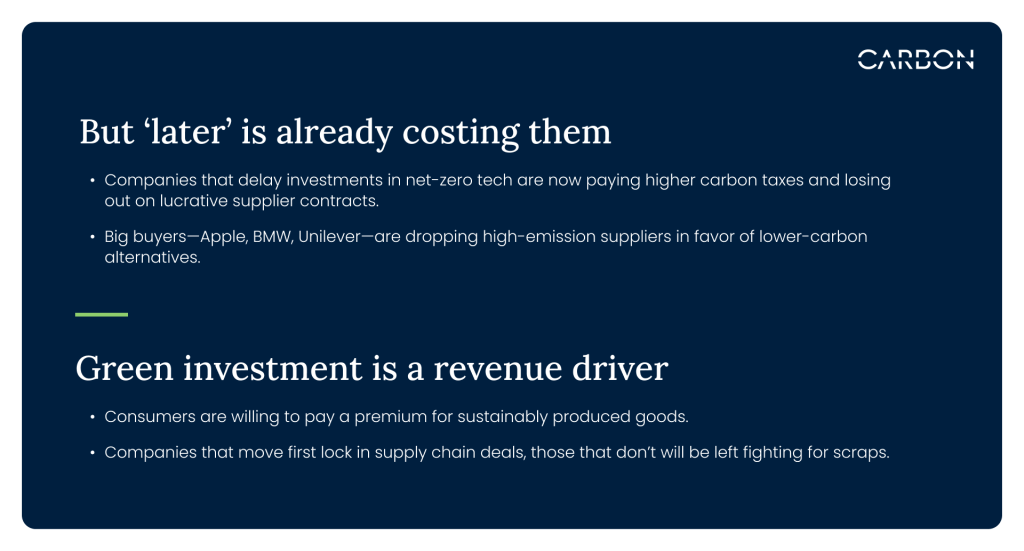
What this means: Manufacturers that see sustainability as a cost center instead of a competitive advantage are already losing market share.
The Greenwashing Problem: Who’s Faking It?
Some manufacturers know they should be doing more. So instead, they just make it look like they are.
Greenwashing is rampant in the industrial sector. A company might advertise its “low-carbon” products while still using fossil-heavy processes behind the scenes. Others offset emissions on paper but do little to reduce their actual footprint.
Carbon accounting loopholes keep high-emission manufacturers afloat—for now.
- Many companies claim carbon neutrality by buying offsets that don’t actually remove carbon from the atmosphere.
- Some manufacturers cherry-pick emissions data to look more sustainable while their supply chains remain fossil-fueled.
Regulators and investors are catching on.
- The SEC’s new climate disclosure rules will force companies to report real emissions data. No more selective transparency.
- The EU’s Green Claims Directive is cracking down on vague sustainability claims. If a company says it’s net-zero, it better have proof.
What this means: Manufacturers that don’t back up their claims will lose credibility and business.
The Innovation Gap: Why Some Industries Are Stuck
For some industries, net-zero is a nightmare.
Sectors like cement, steel, and petrochemicals depend on fossil fuels at a fundamental level. They can’t just switch to renewables overnight like tech or consumer goods companies can.
High-carbon industries are struggling to adapt.
- Cement production emits 8% of global CO₂, and alternatives like green cement are still expensive.
- The petrochemical industry relies on fossil-based feedstocks, there’s no easy replacement yet.
But waiting isn’t an option.
- The EU’s Carbon Border Adjustment Mechanism (CBAM) regulation will slap high tariffs on imported high-carbon materials.
- Buyers are shifting to lower-emission alternatives, leaving high-carbon manufacturers with shrinking demand.
What this means: If an industry hasn’t figured out how to decarbonize yet, it better figure it out fast, or risk losing market share to those who have.
There’s No More Room to Stall
1. Companies that delay green investment are already losing contracts and paying higher compliance costs.
2. Greenwashing is becoming a reputational and legal liability, if a company can’t back up its sustainability claims, it’s in trouble.
3. Industries struggling to decarbonize can’t afford to wait. Regulations and buyer expectations are moving too fast.
The window for manufacturers to get ahead of the curve is closing. The leaders are pulling ahead and the laggards are about to get left behind.
Next up: What’s coming next and how manufacturers can win in the net-zero economy.
How Net-Zero Manufacturing Will Be Won
Manufacturers who think sustainability is just about cutting emissions are missing the big picture. This is more than just a compliance game anymore. It’s about who will dominate the next era of industrial production.
Companies that electrify their processes, embrace automation, and rethink supply chains will lead the net-zero transition. Here’s how the next phase of sustainable manufacturing will play out.
The Next-Gen Manufacturing Models Taking Over
For years, manufacturing was about scaling bigger and cutting costs. Now? It’s about scaling smarter and cutting waste.
Hyper-Efficient, AI-Optimized “Dark Factories” Are Changing the Game
- AI-powered factories are running with minimal human intervention, slashing energy waste and maximizing uptime.
- Some production facilities don’t even need lights—hence the term “dark factories”—because automation handles everything.
- Companies like FANUC in Japan already mass-produce robots using their own robotic workforce, making automation in manufacturing itself a self-improving process.
Regional Supply Chains Will Replace Global Sourcing
- The days of shipping parts across the world just to save a few dollars on labor are fading.
- Localized production is cutting transport emissions, shortening lead times, and making supply chains more resilient.
- Governments are backing this shift—the U.S. Inflation Reduction Act and the EU’s Green Industrial Plan are pouring billions into bringing manufacturing back home.
What this means: The manufacturers that automate and localize first will be the most competitive. Those relying on outdated global supply chains will be left dealing with delays, higher costs, and regulatory headaches.
Why Industrial Electrification Is a Bigger Deal Than AI
AI gets all the hype, but the real transformation is happening in how factories are powered.
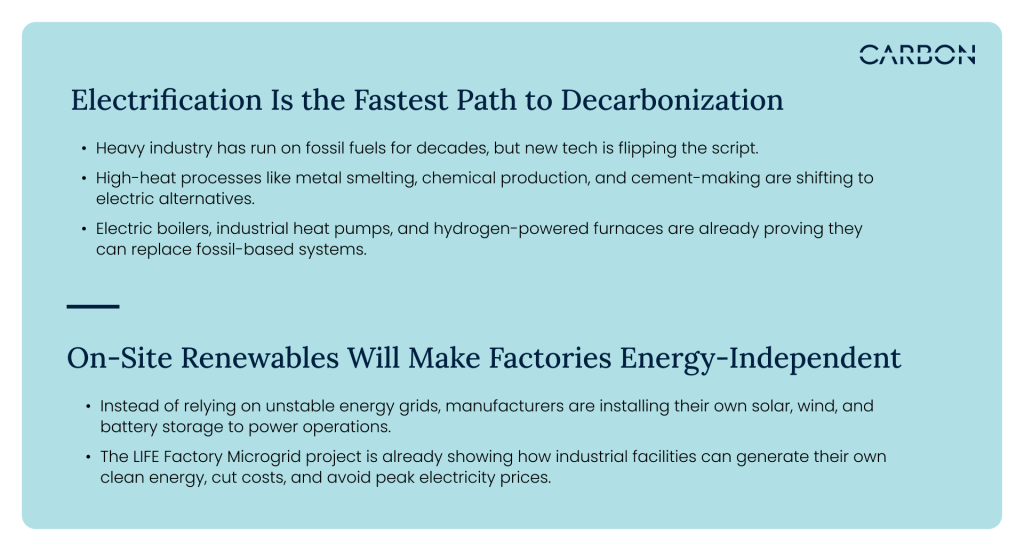
What this means: AI can optimize energy use, but without clean electricity, manufacturers are still running on outdated systems. The companies that electrify now will be ahead of the curve when fossil fuel costs rise and regulations tighten.
The Rise of Net-Zero Industrial Trade Agreements
Trade is about price, quality, and, most importantly, carbon impact. The manufacturing world is splitting into two categories: those who meet net-zero trade standards and those who get shut out.
Low-Carbon Trade Partnerships Are Reshaping Global Supply Chains
- The EU’s Carbon Border Adjustment Mechanism (CBAM) is just the beginning. If your products aren’t low-carbon, you’ll pay tariffs just to enter premium markets.
- The U.S. and Japan are considering similar carbon-based trade policies, which means high-emission manufacturers will have fewer places to sell their goods.
Companies That Decarbonize Will Own the Premium Markets
- The biggest buyers—Apple, Tesla, and Unilever—are now requiring their suppliers to prove carbon reductions.
- Manufacturers that invest in clean production will get first dibs on high-value contracts.
- Those who don’t will be left competing for shrinking, price-driven, lower-tier markets.
What this means: Sustainability is a ticket into the best global markets. Manufacturers that fail to cut emissions will see doors closing fast
The Future of Automation in Manufacturing Belongs to Those Who Adapt First
1. Automation, AI, and localized production will define the most efficient manufacturers.
2. Electrification and clean energy adoption will be the real decarbonization game-changers.
3. Net-zero trade policies will separate future market leaders from companies that get left behind.
The winners in this race are reinventing how manufacturing works.
Next up: Why net-zero is about competitive survival.
Net-Zero Is Reshaping What It Means to Be a Manufacturer
A company that makes products is no longer just a manufacturer. It’s also a resource steward, an energy generator, and a technology integrator.
The lines between industries are blurring, and the most successful manufacturers will be the ones that embrace this shift.
1. Factories that generate their own energy will be energy hubs.
2. Manufacturers that track and eliminate material waste will also sell services, circular systems, and lifecycle management.
3. AI-driven efficiency will make production continuously adaptive, flexible, and resilient.
The Shift Has Already Begun
The biggest question now is how far manufacturers are willing to push what’s possible.
The factories of the future won’t look like the factories of the past. Apart from being cleaner, they’ll be smarter, leaner, more autonomous, and more valuable to the world than ever before.
This is not a transition. But a transformation.

